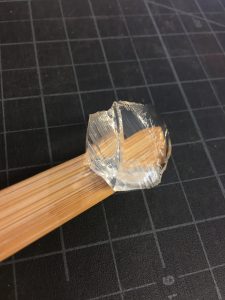Though we generally frown on the presence of food in the Rare Books department due to the potential damage it could do to our collections, would you believe that a favorite summertime dessert is perfectly welcome in our conservation lab? While we use a number of regular household items in unusual ways here, one that never fails to surprise people outside of the lab is gelatin.
While you may cook gelatin with sugar, fruit flavoring, and a little food coloring, our end uses require it uncut and lab grade (rather than food grade). In essence, gelatin is a protein dissolved in water that becomes a rigid structure when cooled. The matrix-like arrangement that gelatin molecules take on as it cools is what makes it so great for fun food times in your kitchen, but in the conservation lab, we value it for working properties like solubility, tack and that stiff gel characteristic.
We use gelatin in various viscosities for a number of applications. Weak gelatin applied either in a bath or as a wash (taking advantage of its solubility) is perfect to size paper after it has been washed to give it that crisp crinkle sound rare books lovers know and love so well. Stronger gelatins take advantage of the gelatin’s tack and are used to adhere tissue repairs to substances like parchment, which are stretched and dried animal hides. Due to the way these hides were first created, the water found in some other lab-favorite adhesives like paste could warp them or even convert them to something more akin to rawhide than the pages of a book.
This week, we mixed up a 6% gelatin adhesive to “guard” the damaged gutter of a medieval manuscript written on vellum (parchment prepared for calligraphy). Rather than applying it as a wet adhesive, we took advantage of the stiff gel characteristic and waited until it was cool, then massaged it as a malleable solid into the repair tissue which we then applied to the vellum. This way, the repairs introduced as little absorbable liquid to the original materials as possible and avoided the negative effects we might see from other adhesives.
We’re guessing it’s been a while since you really took a moment to marvel at the jiggle in your gelatin, but next time you’re at your great Aunt Betsy’s Thanksgiving dinner and a can-shaped glob of gelatin-rich cranberry sauce is plopped on your plate, we encourage you to take a minute and really appreciate it. In another life, it might have been used to repair a rare book.






Add a comment to: J-E-L-L-Oh Don’t Eat That